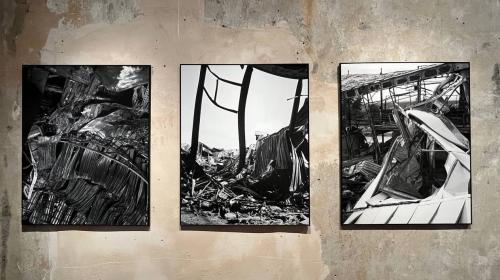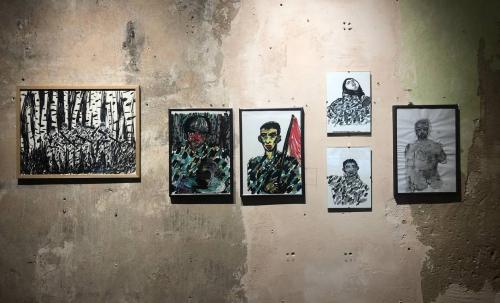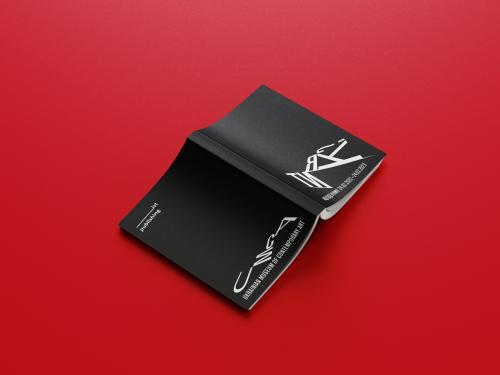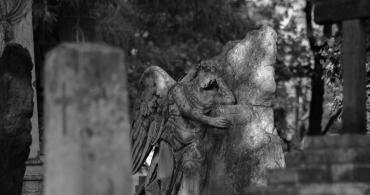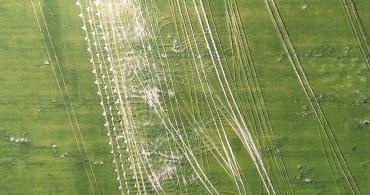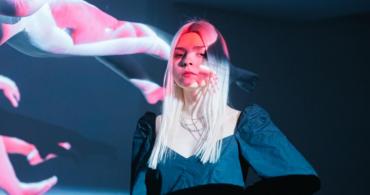Chronology of War and Art. The Unveiling of The Wartime Art Archive
2 листопада, 2023
The Wartime Art Archive is a curatorial observation of Ukrainian art after the russian full-scale invasion of Ukraine. Since February 24, 2022, a team of researchers and curators have been following in real-time the multimedia responses of Ukrainian artists to the war and the changing cultural scene in a time of social transformation. Thus, they are building the Wartime Art Archive, which will soon be open to a wide range of professionals and researchers.
With this publication, we are launching a series of introductory essays and interviews in partnership with the Museum of Contemporary Art NGO and UMCA (Ukrainian Museum of Contemporary Art) about Ukrainian art at the time of full-scale war. The archive’s co-curator and art historian Halyna Hleba tells ArtsLooker how the archive began and how the digital database became a series of exhibition projects.
With this publication, we are launching a series of introductory essays and interviews in partnership with the Museum of Contemporary Art NGO and UMCA (Ukrainian Museum of Contemporary Art) about Ukrainian art at the time of full-scale war. The archive’s co-curator and art historian Halyna Hleba tells ArtsLooker how the archive began and how the digital database became a series of exhibition projects.
On the first anniversary of the full-scale invasion, February 24, 2023, Ukrainian social media were filled with memorial posts. Disturbed by the date on the calendar, we shared our lingering traumatic memories, emotions, fears, pain, and shock of the first days of the aggression. Some of these posts included reproductions of works by Ukrainian artists that they published in the first days of the invasion as a quick reaction to the events. These apt, poignant, and painful artistic images complemented the words of social media users and literally visualized what is still hard to put into words in a comprehensive way.
A year earlier, with the beginning of the full-scale invasion, we, together with Olga Balashova and Tetiana Lysun, began to follow the digital artistic trail of artists on social media. It turned into the Wartime Art Archive, which emerged quite spontaneously, so we constructed its conceptual and thematic framework, form, and content criteria literally “off the cuff”. It is quite difficult to put the frantic time and its twists and turns into a clear structure when the events are still unfolding. Probably, that is why archives are formed and compiled from a distance when time sifts through memories and leaves the most important ones. Our approach was the opposite: we relied on the sporadic character of social media, throwing a wave of artistic responses into the public sphere, which we thought was important to record and preserve to be able to comprehend them later.
However, three major principles of developing the archive have not changed since the very start:
The timeframe of the archive is determined by martial law, with archiving commencing from the date of the introduction of new legal conditions for society and the country, and concluding upon the termination of martial law in Ukraine. We do not know when it will happen, so the archive is complemented with calendar dates and works of art on a permanent basis.
The archive structure is based on the chronological principle, and it is crucial for us to recreate the timeline of events that have already become historical and decisive for Ukrainians and to display artworks as artists’ reactions to these events with precise dates of their creation and public appearance. From a broader perspective, we want to think of this archive as a historical source of information about the images, moods, and states of society during the war.
A year earlier, with the beginning of the full-scale invasion, we, together with Olga Balashova and Tetiana Lysun, began to follow the digital artistic trail of artists on social media. It turned into the Wartime Art Archive, which emerged quite spontaneously, so we constructed its conceptual and thematic framework, form, and content criteria literally “off the cuff”. It is quite difficult to put the frantic time and its twists and turns into a clear structure when the events are still unfolding. Probably, that is why archives are formed and compiled from a distance when time sifts through memories and leaves the most important ones. Our approach was the opposite: we relied on the sporadic character of social media, throwing a wave of artistic responses into the public sphere, which we thought was important to record and preserve to be able to comprehend them later.
However, three major principles of developing the archive have not changed since the very start:
The timeframe of the archive is determined by martial law, with archiving commencing from the date of the introduction of new legal conditions for society and the country, and concluding upon the termination of martial law in Ukraine. We do not know when it will happen, so the archive is complemented with calendar dates and works of art on a permanent basis.
The archive structure is based on the chronological principle, and it is crucial for us to recreate the timeline of events that have already become historical and decisive for Ukrainians and to display artworks as artists’ reactions to these events with precise dates of their creation and public appearance. From a broader perspective, we want to think of this archive as a historical source of information about the images, moods, and states of society during the war.
Our observational focus is on social media, which served as an accessible public space for expression during the initial months of the invasion. Back then, it was also the only space where the viewer could (even if by chance, but therefore more easily) encounter art. After the de-occupation of northern Ukraine and in the rear cities, teams of cultural activists, along with preserving collections and volunteering, managed to reorganize and reopen cultural institutions, resume exhibition and artistic activities, and engage and adapt IDPs.
In the early days, such archiving was our way of overcoming frustration and confusion, helping us to keep our focus and shift our attention from the affective scrolling of news and events to what is the subject of our research interest and expertise: visual art. Later, this collection of images turned into a kind of database and, in April 2022, into exhibition projects. The first of them was Piazza Ucraina at the Venice Biennale (curated by Lizaveta German, Borys Filonenko, and Maria Lanko, with architecture and display design by Dana Kosmina), an open-air project at one of the major global art industry events, which included posters with artworks that responded to the war.
In June 2022, only three months after the full-scale invasion, we opened a year-long exhibition project, Wartime Art Archive, with an exhibition series at The Naked Room Gallery in Kyiv. The curators of further exhibition projects based on the archive were the wider team of the Museum of Contemporary Art – Olga Balashova, Halyna Hleba, Tetiana Lysun, Anna-Mariia Kucherenko, and Yuliia Karpets. In July 2022, the Art of Coping with War exhibition opened at the World Bank office in Washington, DC. In January 2023, the Who Holds Up the Sky? exhibition opened at the Museum of Fine Arts in Boston, USA. In February 2023, we launched a several-month long solidarity exhibition project with the ARS AEVI Museum in Sarajevo, Bosnia and Herzegovina. In March 2023, we became a part of the main program of the EMOP Berlin Festival of Photography and prepared an exhibition with the Museum für Kommunikation Berlin. In June 2023, with the Past/Future/Art memory culture platform, we opened a large-scale exhibition project, HOW ARE YOU? Exhibition and Discussion at the Ukrainian House, where we presented hundreds of works created after February 24, 2022, based on the archive’s timeline. About 100 artists and art groups took part in the project.
Along with exhibition activities, the archive continues to grow and slowly becomes a research source for not only culture theorists and art historians but also social sciences scholars who explore the transformation of Ukrainian society during the war. From within the archive, one can trace particular trends, images, and forms that change and reflect specific periods of living with collective war trauma, as well as the myriad of experiences in the dense reality of wartime in Ukraine and beyond.
Today, we are not only working on the content but also preparing the beta version of the website of the archive for the public presentation. It requires developing a platform to accommodate the amount of information we need with a specific internal architecture for searching and displaying data, which is necessary to manifest the chronological principle of the timeline.
In the early days, such archiving was our way of overcoming frustration and confusion, helping us to keep our focus and shift our attention from the affective scrolling of news and events to what is the subject of our research interest and expertise: visual art. Later, this collection of images turned into a kind of database and, in April 2022, into exhibition projects. The first of them was Piazza Ucraina at the Venice Biennale (curated by Lizaveta German, Borys Filonenko, and Maria Lanko, with architecture and display design by Dana Kosmina), an open-air project at one of the major global art industry events, which included posters with artworks that responded to the war.
In June 2022, only three months after the full-scale invasion, we opened a year-long exhibition project, Wartime Art Archive, with an exhibition series at The Naked Room Gallery in Kyiv. The curators of further exhibition projects based on the archive were the wider team of the Museum of Contemporary Art – Olga Balashova, Halyna Hleba, Tetiana Lysun, Anna-Mariia Kucherenko, and Yuliia Karpets. In July 2022, the Art of Coping with War exhibition opened at the World Bank office in Washington, DC. In January 2023, the Who Holds Up the Sky? exhibition opened at the Museum of Fine Arts in Boston, USA. In February 2023, we launched a several-month long solidarity exhibition project with the ARS AEVI Museum in Sarajevo, Bosnia and Herzegovina. In March 2023, we became a part of the main program of the EMOP Berlin Festival of Photography and prepared an exhibition with the Museum für Kommunikation Berlin. In June 2023, with the Past/Future/Art memory culture platform, we opened a large-scale exhibition project, HOW ARE YOU? Exhibition and Discussion at the Ukrainian House, where we presented hundreds of works created after February 24, 2022, based on the archive’s timeline. About 100 artists and art groups took part in the project.
Along with exhibition activities, the archive continues to grow and slowly becomes a research source for not only culture theorists and art historians but also social sciences scholars who explore the transformation of Ukrainian society during the war. From within the archive, one can trace particular trends, images, and forms that change and reflect specific periods of living with collective war trauma, as well as the myriad of experiences in the dense reality of wartime in Ukraine and beyond.
Today, we are not only working on the content but also preparing the beta version of the website of the archive for the public presentation. It requires developing a platform to accommodate the amount of information we need with a specific internal architecture for searching and displaying data, which is necessary to manifest the chronological principle of the timeline.
Collecting an archive is obviously not the first thing a person does when a major war escalates in their country. But in Ukraine, since the beginning of the Russian-Ukrainian war in 2014, many notable archiving initiatives and projects have emerged. Perhaps crisis archiving is a kind of artistic professional deformation and affective action by those who are used to and know how to do it. Or it could be an impact of the familiar fear of losing cultural artifacts and phenomena – something that has happened many times in the history of Ukrainian culture. The fact that the destruction of culture, its centers, and its holder has become one of the Russians’ goals in this war also intensifies this fear. The surge in archival practices during current events seems like an opportunity to create multiple “backups” of ourselves today for the future so that the possible loss of any source of information or archive does not erase large, significant pieces of memory and knowledge about this time, especially since this is no longer a short period of history but our new reality.
Research and processing of materials, development of the Wartime Art Archive website, and media partnership with Suspilne.Culture and ArtsLooker are implemented by the Museum of Contemporary Art NGO with kind support of the Fritt Ord Foundation (Norway) and Sigrid Rausing Trust (UK).
Author:
Halyna Hleba,
art historian, Ukrainian art and photography researcher
The article is available in Ukrainian on Suspilne.Culture
Research and processing of materials, development of the Wartime Art Archive website, and media partnership with Suspilne.Culture and ArtsLooker are implemented by the Museum of Contemporary Art NGO with kind support of the Fritt Ord Foundation (Norway) and Sigrid Rausing Trust (UK).
Author:
Halyna Hleba,
art historian, Ukrainian art and photography researcher
The article is available in Ukrainian on Suspilne.Culture
To read more articles about contemporary art please support Artslooker on Patreon
Share:

